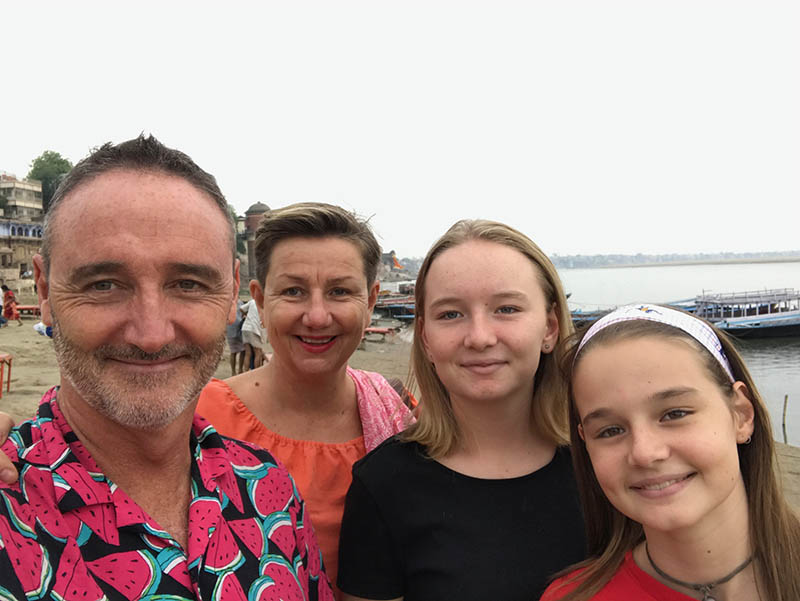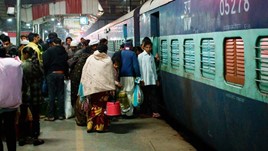
By Kate Duthie
Travel Writer12 Aug 2019 - 5 Minute Read
Train platforms in India have many purposes. They are places to eat, to sleep (often in large family groups), to pray, to shoo away dogs. And to wait. Once we get over the irritation of finding our 8:40pm train's new departure time has been moved to 1am (despite checking online multiple times), we settle into life in the crowded (air-conditioned) waiting room. Furnished with plastic seats and with access to a small food stand, it beats the 104°F (40°C) heat of the train platform. I chat to a lad from southern India, on his way to the Himalayas to trek and then to Italy to teach English. A 20/20 cricket match blares from the TV, and as the crowds come and go with each new departure, there are new faces and conversations to be had.
We punctuate our long wait with trips out to the platform to warm up – that AC has a real kick – and survey its own changing landscape. Dogs fight before limping away, people sleep, and eat. And wait.
Finally, at 12:30 we head to platform 13, where we are assured by a very helpful young man (who may or may not work for Indian railways) that our newly arrived and cleaned train will be waiting. Instead, we find a platform packed with people, luggage, boxes, parcels, and stray dogs. But no train. Also, no station staff, no working information screens and no way of knowing when the train will come. Will it come? So we, too, wait.

I am traveling with my husband, and our two daughters, 12 and 15. On this trip they have been confronted by many things – young children begging and sleeping rough, a man with no arms waving his stumps in their faces, people with shocking disabilities and birth defects waiting outside entrances to monuments, hoping for donations. The girls seemed to take it all in their stride – if it upset or worried them, they didn’t say so. And now, as they sit, tired, pathetic, and hot, on the seething platform, nothing seems to bother them. In part, because they are too exhausted to care, and also because, as parents, you have to put on the face you want your children to believe in. So, while I’m anxious about what will happen next, I play the part of the carefree traveler, awaiting the next stage of the adventure. In reality, I wonder how the night will end.
At 2am, our train to Varanasi arrives without fanfare, announcement, or introduction, slowly sliding along the tracks as the whole platform comes to hurried life to get on board. But this is no empty, cleaned train ready to receive us; this train is already packed with people – tired, hot, stinking. People who had endured god knows what during their long stop-and-go to Delhi. As we rush along the platform, frantically looking for our carriage number, we pass the lowest-class carriages where people seem stuffed in, limbs escaping windows, along with an unbelievable stench that could only be created by a sweaty mass of humanity confined for hours. Organised chaos prevails as us platform-dwellers swarm the train, looking for our assigned spaces.

We had secured one of the three, hard-to-book, air-conditioned cabins with four bunks, but first board the wrong carriage, squeezing our way down the corridor, passing men carrying sacks, bags, and small children, to find four bunks already occupied by another family. For my 12-year-old, who had tripped getting on the train, breaking her sandal, this is the final straw; she breaks down, surrounded by strangers, not caring as she sobs, in exhaustion and disappointment. India has finally broken her. Nothing can console her – not me, not her father or the kind strangers on the train.
We fight our way back along the corridor and onto the platform, eventually finding the right carriage and our empty cabin, which provides relative calm and sanctuary. While our daughter continues to cry, we make up our beds with the fresh sheets and blankets provided, and tuck her in. And then we wait another hour before the train finally departs – now seven hours late – gently rocking us to sleep.
Our return journey, 48 hours later, is more successful. This time, the train is only 10 minutes late, and when it pulls into the platform, we know what to expect. On our first calamitous journey, we had been four panicked, sweaty novices, running along the platform unsure of where to go or how long the train would stop for (would it stop?) to let us find our seats. This time, even our youngest daughter has the confident gait of a seasoned Indian train traveler, strolling straight to the final carriage where our clean, crisp sheets are the only things waiting.


Discover similar stories in
discovery



No Comments